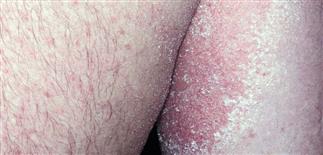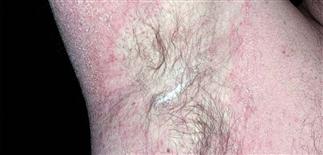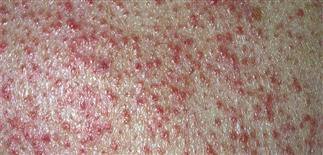156
Miliaria

Miliaria crystallina. Clear, superficial vesicles developed in this patient that was covered with blankets in warm weather.

Miliaria crystallina. Lesions occurred in crops and were confluent. Many vesicles have ruptured and the skin is desquamating.

Miliaria rubra. Intense pruritus occurred in this neonate who was over dressed. Nonconfluent red papules about the neck where friction had occurred. Lesions resolved spontaneously.

Miliaria profunda is characterized by small non-erythematous papules and pustules occurring on the trunk and extremities.
DESCRIPTION
Clear to red papules that result from obstruction of eccrine sweat ducts.
HISTORY
Very common in newborns and infants who are ‘bundled’ or placed in warm environments, and in febrile infants. Miliaria can last for hours to days. Three types. • Miliaria crystallina. Eccrine obstruction at level of stratum corneum. Most common type in newborns. Caused by warming lights and tight bundling. • Miliaria rubra. ‘Prickly heat’ or ‘heat rash.’ Intraepidermal eccrine obstruction. Redness due to release of local inflammatory mediators. • Miliaria profunda. Dermal–epidermal eccrine duct obstruction. Rare in newborns. Cause unknown, although a polysaccharide produced by certain strains of Staphylococcus epidermidis may play a role.
PHYSICAL FINDINGS
• Miliaria crystallina. Multiple subtle ‘dewdrop’ superficial vesicles that easily break. Common in intertriginous areas such as neck folds, face (especially forehead), and trunk. • Miliaria rubra. Non-follicular pustules and vesicles. Same distribution as for miliaria crystallina. • Miliaria profunda. Small non-erythematous papules and pustules occurring on trunk and extremities.
TREATMENT
Cool bath and avoidance of tight bundling.







